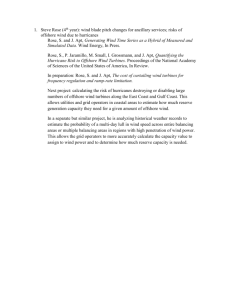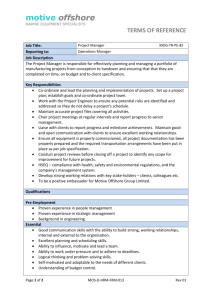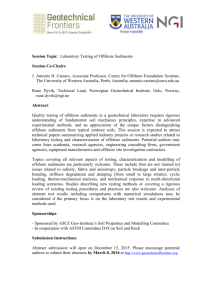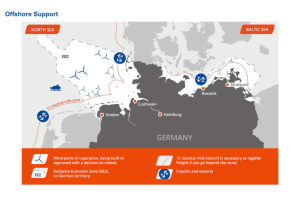Samuel Swenson October 13, 2009
advertisement
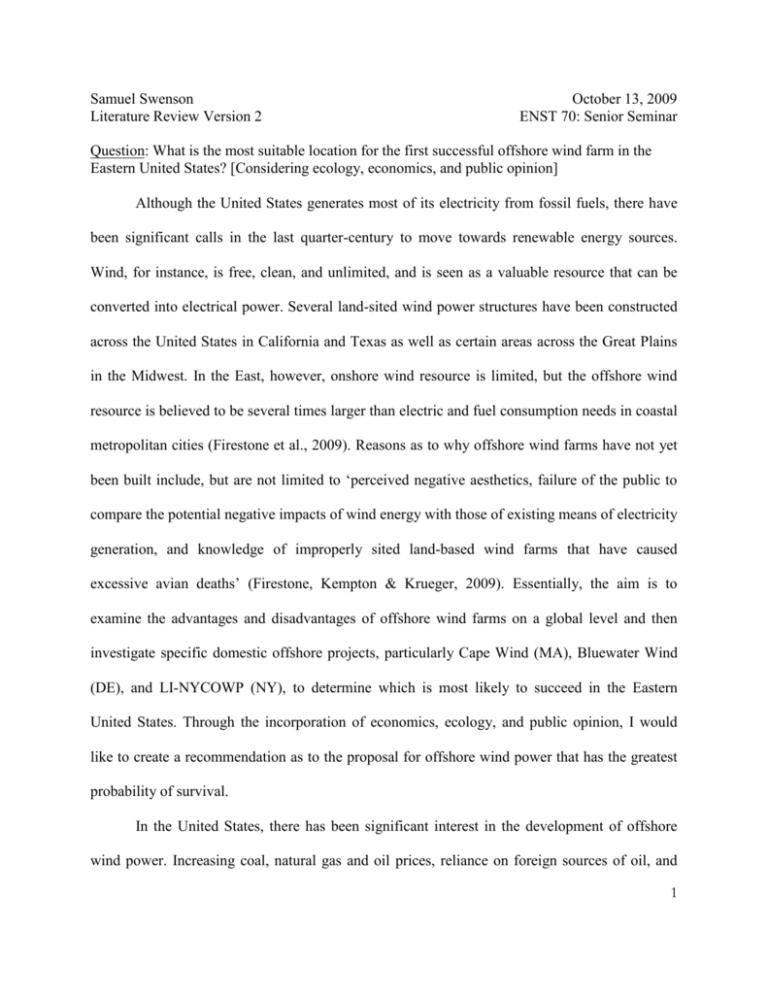
Samuel Swenson Literature Review Version 2 October 13, 2009 ENST 70: Senior Seminar Question: What is the most suitable location for the first successful offshore wind farm in the Eastern United States? [Considering ecology, economics, and public opinion] Although the United States generates most of its electricity from fossil fuels, there have been significant calls in the last quarter-century to move towards renewable energy sources. Wind, for instance, is free, clean, and unlimited, and is seen as a valuable resource that can be converted into electrical power. Several land-sited wind power structures have been constructed across the United States in California and Texas as well as certain areas across the Great Plains in the Midwest. In the East, however, onshore wind resource is limited, but the offshore wind resource is believed to be several times larger than electric and fuel consumption needs in coastal metropolitan cities (Firestone et al., 2009). Reasons as to why offshore wind farms have not yet been built include, but are not limited to ‘perceived negative aesthetics, failure of the public to compare the potential negative impacts of wind energy with those of existing means of electricity generation, and knowledge of improperly sited land-based wind farms that have caused excessive avian deaths’ (Firestone, Kempton & Krueger, 2009). Essentially, the aim is to examine the advantages and disadvantages of offshore wind farms on a global level and then investigate specific domestic offshore projects, particularly Cape Wind (MA), Bluewater Wind (DE), and LI-NYCOWP (NY), to determine which is most likely to succeed in the Eastern United States. Through the incorporation of economics, ecology, and public opinion, I would like to create a recommendation as to the proposal for offshore wind power that has the greatest probability of survival. In the United States, there has been significant interest in the development of offshore wind power. Increasing coal, natural gas and oil prices, reliance on foreign sources of oil, and 1 concerns about global climate change have made domestic, renewable, and low carbon sources of energy particularly attractive (Snyder & Kaiser, 2009). Offshore wind energy is particularly appealing because installing turbines far from the coast will nearly eradicate the problem of negative visual impact and loud noise. Furthermore, in comparison to onshore wind farms, stronger winds offshore imply greater productivity that may offset the higher cost of installation and operation (Breton & Moe, 2008). As there are several large metropolitan cities on the East coast, these turbines can be located closer to the cities that will use their power, and therefore shorter transmission lines will be required. Finally, as construction will occur completely at sea, there is ‘virtually no limit’ as to the size and design of the turbines, which leaves room for innovation and improved efficiency (Breton & Moe, 2008). The focus of wind power has already begun to shift towards the coastal zone in several European nations, including Denmark and United Kingdom. Vindeby, the world’s first offshore wind farm (built in 1991), has already begun to be an important player in Denmark’s energy generation process (Chen & Blaabjerg, 2008). The Danish government projects 4000 MW of electricity from offshore wind farms by 2030, a number equivalent to 40% of the annual Danish electricity consumption (Chen & Blaabjerg, 2008). In the United Kingdom, for instance, the offshore wind environment has proven to be quite reliable because of lower turbulence and higher energy density, which means that up to 50% more electricity can be generated in comparison to an equivalent land-based wind farm (Wilson & Elliott, 2009). Throughout Europe, one of the clearest trends in the offshore wind industry is the increasing size of wind farms, as well as the increased progress into deeper waters and an increased willingness to use larger turbines (Snyder & Kaiser, 2009). Using European nations as examples, the United States will 2 have a framework to which it can refer as the American offshore wind industry moves towards coastal zones. Specifically, the United States has several proposals to begin the construction of offshore wind farms on the Eastern coastline. The Cape Wind project is likely the best known and most controversial project: EMI (Energy Management Incorporated) plans to install 130, 3.6 MW turbines approximately 7 miles off the coast of Cape Cod on an area called horseshoe shoal (Snyder & Kaiser, 2009). Although it had first been proposed in 2001, the project has undergone a number of delays as a result of public opposition by local and powerful activists, such as Bill Koch, Mitt Romney, and the Kennedy family (Snyder & Kaiser, 2009). Problems with the wind farm project are associated with concerns over negative aesthetic impact and excessive avian death. More importantly, however, is that construction and maintenance are much more complex and time consuming than for an onshore farm, and there are significant financial risks associated with investing in an immature business (Markard & Petersen, 2009). A cost-benefit analysis, considering the financial costs and risks, the ecological effects to marine life, and the opinion of the surrounding residents is necessary to determine whether Cape Cod is a suitable area for an offshore wind farm. Delaware’s Bluewater Wind project is not as publicized, but still aspires to be one of the more significant offshore wind power projects in the United States. Delaware is more than three times the size of Cape Cod, and the state relies heavily on fossil fueled power plants for its energy generation (Firestone et al., 2009). Although there is some opposition to the plan for those with a primary home near the Delaware coast, statewide support is 77.8% as opposed to only 4.2% opposition (Firestone et al., 2009). Another project in its early stages is taking shape in New York, appropriately named the Long Island – New York Offshore Wind Project. The 3 plan seeks to generate 350 MW of power with turbines off the Rockaway Peninsula in the Atlantic Ocean. A wind facility of this size would effectively displace 400,000 tons of CO 2 annually, the equivalent of removing 68,000 cars from local roads (Con Edison). New York is one of the most densely populated cities in the world, and it seems as though an offshore wind farm would accommodate significantly high energy needs. Both the Bluewater Wind project and Long Island – New York Offshore Wind Project have clear advantages, but the significant shortterm financial risks could prevent either of these projects from being successful. The quantity of electricity generated from offshore wind farms is simply too great for humans to ignore. The advantages of offshore wind power have been successfully demonstrated by European nations, and it is nearly the time for the United States to move towards the coast, given the unusually high American demand for energy. Projects like Cape Wind, Bluewater Wind and LI – NYOWP serve as promising proposals to be the first offshore wind farm in the United States, although an extensive cost benefit analysis is necessary to determine which location is the most viable, and the most likely to experience long-term profitability. 4 Works Cited Barthelmie, R. J. "Modelling and Measuring Flow and Wind Turbine Wakes in Large Wind Farms Offshore." Wind Energy (2009): 431-44. Breton, Simon-Phillipe, and Geir Moe. "Status, plans and techonologies for offshore wind turbines in Europe and North America." Renewable Energy 34 (2009): 646-54. Burton, Bob. "Turbine Opinions Blowing in the Wind." Industrial Wind Energy News [Ontario, Canada] 24 Mar. 2009. Chen, Z., and F. Blaabjerg. "Wind farm - A power source in future power systems." Renewable and Sustainable Energy Reviews 13 (2009): 1288-300. Cutler, Nicholas J. "Characterizing Future Large, Rapid Changes, in Aggregated Wind Power using Numerical Weather Prediction Spatial Fields." Wind Energy (2009): 542-55. The Economics of Wind Energy. AWEA: American Wind Energy Association. Web. <http://www.awea.org/pubs/factsheets/EconomicsOfWind-Feb2005.pdf>. Firestone, Jeremy, Willett Kempton, and Andrew Krueger. "Public Acceptance of Offshore Wind Power Projects in the USA." Wind Energy 12 (2009): 183-202. Hurst, Timothy B. "Wind Turbine Output Boosted 30% by Breakthrough Design." CleanTechnica.com (2009). Ladenburg, Jacob. "Visual impact assessment of offshore wind farms and prior experience." Applied Energy 86 (2009): 380-87. Lauber, Volkmar. Switching to Renewable Power A Framework for the 21st Century. Minneapolis: Earthscan Publications Ltd., 2005. Long Island, New York City Offshore Wind Project. Web. 14 Oct. 2009. <http://www.linycoffshorewind.com/Default.html>. Madden, Chris. "Wind Farms." Cartoon. Chris Madden Cartoons. Web. <http://www.chrismadden.co.uk/eco/windfarm-wind-turbine.gif>. Markard, Jochen, and Regula Petersen. "The offshore trend: Structural changs in the wind power sector." Energy Policy 37 (2009): 3545-556. Photograph. Wind EIS: Diagram of a Wind Turbine. WindEIS. Web. <http://windeis.anl.gov/guide/basics/turbine.html>. Snyder, Bryan, and Mark J. Kaiser. "A comparison of offshore wind power development in Europe and the US: Patterns and drivers of development." Applied Energy 86 (2009): 1845-856. 5 Williams, Wendy, and Robert Whitcomb. Cape Wind: Money, Celebrity, Class, Politics, and the Battle for Our Energy Future on Nantucket Sound. New York: Public Affairs, 2007. Wilson, Jennifer C., and Michael Elliott. "The Habitat-creation Potential of Offshore Wind Farms." Wind Energy 12 (2009): 203-12. "Wind Industry Statistics." American Wind Energy Association. Web. <http://www.awea.org/faq/wwt_statistics.html>. Zaaijer, M. B. "Review of Knowledge Development for the Design of Offshore Wind Energy Technology." Wind Energy (2009): 411-30. 6

